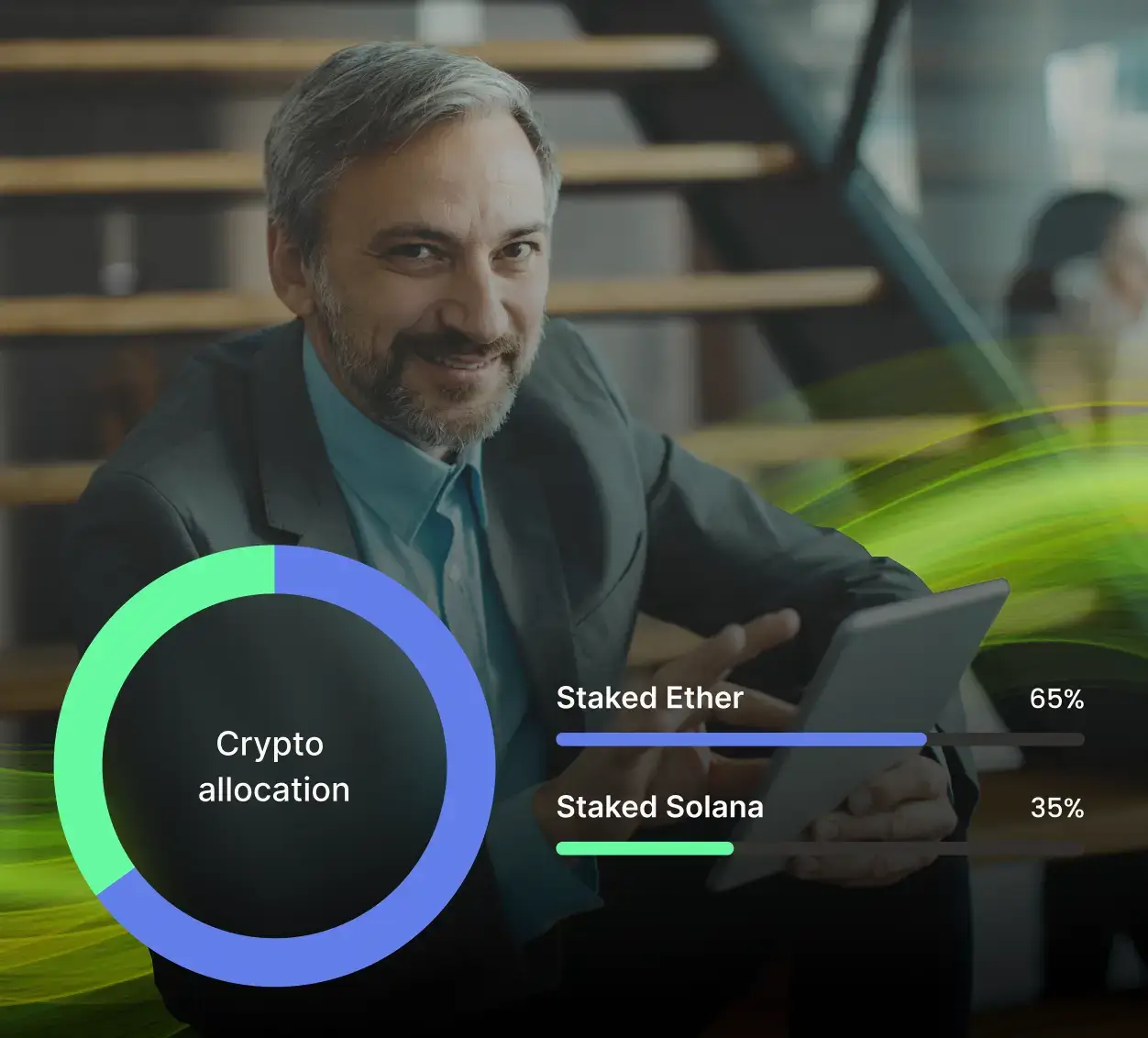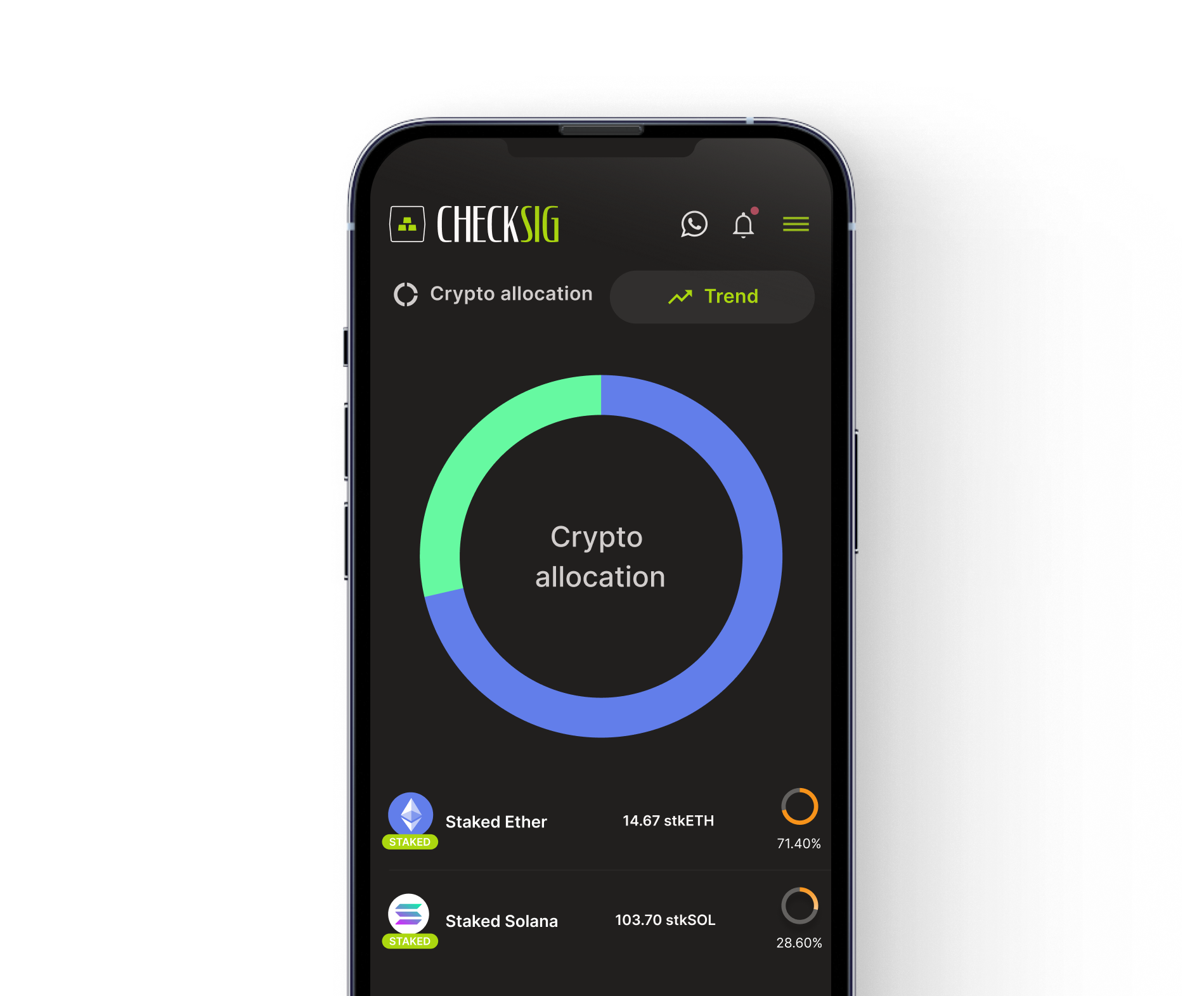
What is staking
Staking is the job of updating the blockchain of Proof-of-Stake crypto, such as Ether or Solana. Anyone can do it, as long as they provide adequate collateral, in return for receiving a remuneration.
1. The Collateral
To stake a crypto, you pledge an amount of that crypto as collateral to guarantee the honesty with which you will perform the job.
2. The Job
The greater the collateral provided, the more reliable you are considered and thus more involved in updating the blockchain.
3. The Reward
The remuneration you receive, paid in the same crypto, is proportional to the collateral provided and the actual job performed.
With CheckSig, you can enjoy the staking remuneration without worrying about the associated job: we do it for you
The remuneration is always advantageous compared to simply holding without staking!

Staking without worries
Simple
You can manage staking from your Private Area, either independently or with the assistance of your account manager, without any time or amount constraints.
Secure
We protect your crypto with insurance coverage, impeccable SOC standards, and transparent processes.
Profitable
Every month, your remuneration is credited to you in crypto and, if you want, you can stake it as well.
Make your crypto earn
in a simple and secure way
Estimate Your Reward
Seize the opportunity to grow your crypto capital; don’t let it sit idle.
In the last month our clients have received (on annual basis):
Ether
2.66%
Solana
5.72%
Last update: 14 November 2025
Crypto
€
Time horizon (term)
Total at term*
0.00000000 SOL
*The remuneration at term is estimated using what CheckSig has achieved in the last month, gross of withholding taxes and fees. Past achievements are indicative only and there is no certainty that future rewards will be comparable.
Frequently Asked Questions
Why does staking offer a remuneration?
Updating the blockchain is real job, which is why a financial incentive is needed to ensure someone does it. The remuneration is the incentive for this job, crucial for keeping the network secure and protecting it from fraud and attacks.
What are the risks?
The collateral you provide can be confiscated (slashing) in case of dishonest behavior when updating the blockchain. However, if you operate honestly, the risk is purely theoretical. This is why it’s essential to rely on trustworthy platforms like CheckSig, which not only offers technical expertise but also provides insurance coverage and adheres to high operational standards certified by SOC attestations.
Additionally, the staking remuneration is variable and depend on market conditions. Past performance is only indicative and does not guarantee similar rewards in the future.
Lastly, the general risks associated with holding crypto, such as market volatility, always apply.
Do the insurance guarantees also cover staking?
Yes, our insurance guarantees cover all of CheckSig’s operations, across all crypto. In addition, staking benefits from extra insurance coverage provided by our partners.
What are the advantages?
The primary advantage of staking is the remuneration associated with the job of updating the blockchain.
Additionally, staking contributes to the security of the blockchain: you earn for your job because everyone benefits from it.
What are the disadvantages?
It is not possible to directly sell the staked crypto without first returning them to simple custody (unstaking). You can do this at any time, without amount restrictions, with maximum flexibility.
There are no other disadvantages.
What crypto can I stake?
As of now (September 2024), with CheckSig you can stake Ether and Solana. We will soon expand the service to include all Proof-of-Stake crypto that can be held in custody with us.
Can I stake Bitcoin?
No, for Proof-of-Work crypto like Bitcoin, the concept of staking does not exist. Blockchain updates are always compensated but require significant investments in hardware and involve high operational costs, making it feasible only for large industrial groups.
Those who allow Bitcoin staking are in reality providing lending, yielding or farming services, i.e. financial products that involve credit risk and that cannot be offered today by crypto operators.
What is the difference between staking and yielding, farming, or lending?
Staking should not be confused with yielding, farming, or lending. The latter are financial products where returns compensate, either implicitly or explicitly, for lending crypto to a third party, which may not return it.
In contrast, staking is a job, not a financial product. The cryptocurrency is not loaned but used as collateral to guarantee the honest performance of blockchain updating. The remuneration earned is the compensation for this job.
Unfortunately, many operators are ambiguous and call everything staking, although this term should be reserved only for the protocol staking natively provided by Proof-of-Stake protocols.
What does compound staking mean?
It refers to the process of adding back the remuneration to the initial staked amount, allowing you to earn on both the initial amount and the accumulated remuneration. Over time, this compounding effect significantly enhances the overall remuneration, especially in long-term staking strategies.
Compound staking works similarly to compound interest in traditional finance, where you earn interest on both your original investment and the interest that has been already paid so far.
Isn’t there a 32 ETH minimum for staking Ether?
Yes, at the protocol level, this limit exists. However, CheckSig allows pool staking: we pool the funds from various clients staking Ether and add our own proprietary funds to reach a multiple of 32 ETH.
Obviously, the remuneration is divided based on amounts (pro quota) and periods (pro rata temporis) of the collateral provided.
What is the difference between Proof-of-Work and Proof-of-Stake?
When it comes to the updating of blockchain, Proof-of-Work protocols follow a “preventive” logic, requiring an extremely demanding and expensive job, typically within the reach of only large industrial groups, which is subsequently compensated only if performed honestly.
In contrast, Proof-of-Stake protocols follow a “punitive” logic, confiscating the collateral in case of dishonest behavior. The job to do is simpler, within everyone’s reach, also because the only prerequisite is to pledge a crypto amount as collateral.
Where can I learn more about the technical details?
There are many online resources, for example, this page for Ether or this one for Solana.
CheckSig provides the Service as a Virtual Asset Service Provider (VASP) authorized to operate in Italy pursuant to the MEF decree of 13 January 2022, and is registered with the OAM (the Body for the management of the lists of Financial Agents and Credit Brokers). On 01/09/2025, CheckSig submitted to CONSOB its application for authorization as a Crypto Asset Service Provider (CASP) pursuant to Regulation (EU) 2023/1114 (MiCA).
A Comprehensive Range of Services
Staking is just one of the services offered by CheckSig. See also:
Accumulation Plans
Discover accumulation plans: invest while reducing volatility risk.
Trading
Buy, sell, and swap crypto easily, flexibly, reliably, and optimally, even for large amounts.
Custody
Benefit from the security chosen by banks and financial institutions to secure Bitcoin and crypto.
Tax
Enjoy the tranquility to be flawless, with the only tax withholding crypto operator in Italy.
Escrow Holder
Use the escrow holder service for cryptos posted as collateral in a euro loan that you want to provide or be a beneficiary of, or in any other contract.
Training
Access training, reporting and updates from top Bitcoin and crypto specialists.
Strategic Consulting
Seize the opportunities that come from true understanding of Bitcoin and crypto.
Open an account
With your account, you have access to all CheckSig services. Great services, at competitive rates.
Contact us
See the FAQs. For further questions or enquiries, our support is always available.
© CheckSig S.r.l. Società Benefit - P.IVA 11028330964


